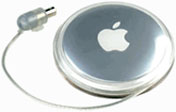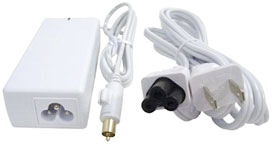Let's face it. Most of us have had at least one bad experience with
an Apple power adapter. From the "yo-yo" adapters with their barrel
jacks to the white brick MagSafe, they've had their fair share of
pitfalls.
For those who seldom remove your 'Book from your desk, you probably
haven't experienced any problems. Aside from a very rare complete
failure, they're solid in this department.
Road warrior laptops tend to accumulate a fair amount of damage and
wear. Eventually, this will cause the breakdown of your adapter, it's
wires, and your DC receptacle. Here are some tips and tricks to avoid
some unnecessary early repairs.
In it's lifetime, Apple has produced several different types of
power adapters.
- PowerBook 1xx Series have a 'normal sized' barrel jack.
- PowerBook 5xx Series have a '4 prong dual voltage' barrel
jack.
- PowerBook 5300 and 190 use an 'ultra-tiny' barrel jack.
 Any PowerBook and iBook after the 190 and 5300 but before the
15" Titanium PowerBook uses an 'oversized barrel jack.' (The standard
for the yo-yo.)
Any PowerBook and iBook after the 190 and 5300 but before the
15" Titanium PowerBook uses an 'oversized barrel jack.' (The standard
for the yo-yo.)- Introduced with the 15" Titanium was the 'smaller barrel jack' with
Charge State Indication LED Ring.
- Finally, MagSafe for the Intel 'Books.
My main gripe with all of the Apple standard power adapters is the
wires.
The wires are incredibly thin and fragile. While this was an
aesthetic decision, and the wires are within rating for the current
they are delivering, they're way too small. I could tear the wire of
the yo-yo adapters without much effort.
Apple also uses a two-wire ground shielded wire. This is great for
thinness but little else. The center wire frays it's insulation and
shorts out on the ground shield after a much shorter time than a setup
with two separate parallel wires would. This causes the infamous "burn
marks" that you'll see on doomed AC adapters - it's the wire shorting
out, causing heat and sparks.
You Can Fix It
Don't be mistaken. If an adapter's wires go bad, it is completely
repairable. There are plenty of guides on the Internet. There are only
two wires, positive and negative. Just remember to exercise caution -
and if you're questioning yourself, you probably shouldn't be doing it
yourself. Get some help from an expert.
The fix: Apple, please. Use two parallel wires. The power cord would
be a bit thicker, but we'll thank you when our power adapters last many
years and survive a lot more beating.
Here are some useful repair guides. Some electronics knowledge is
required, but not too much. Don't be afraid to cut that thing open and
save yourself some money. That said, Low End Mac and I take no
responsibility if you set yourself, your house, or your laptop on fire.
Follow the guides carefully, and don't be afraid to ask for help,
Prevention
The wires are the weakest link, and if you travel with your laptop,
they're going to break eventually. The two most common failure points
are the charging end and the connection to the base. Why? Because
they're bent harshly - a lot.
Don't wrap your wire tightly around your adapter when you pack it.
Let it hang loose a bit. Seriously, it's unnecessary stress on the
wires that contributes to early failure. Make sure that it's not
sharply bent where it's inserted into your computer. Keep the wire
loose and straight. Don't jam it into a corner, and don't crease it. If
you sit with your laptop on your lap, don't crush the wire.
They're fragile. Trust me, it's worth repeating a hundred times.
The Barrel Connector
With any barrel-type connector, there are things you should never do
and things you should always do.
Don't let them get stepped on. This is a very common reason for
failure. When you crush the outer metal ring or snap the golden pin in
the middle, it's toast. They're not that strong and bend really
easily.
Don't let the computer lean on the connector. This is a big one for
those who use it on their lap. Take care not to put pressure or support
the weight of the computer on the connector. This bends the pins - and
that can also ruin the DC board inside your 'Book pretty easily. Same
thing when working on a desk. It's a connector, not an extra foot.
Give them a nice cleaning once in a while. Unplug your adapter. Go
back and reread that. That's pretty important. Once in a while, it's
good to take a Q-tip and run it along the inner contact edges of the
adapter. This doesn't apply to the 'ultra-tiny', 'normal', or '4 prong'
adapters, since they're too small for Q-tips. But if you're having
connection problems (even with the MagSafe), try giving it a gentle
cleaning. Emphasis on gentle - and absolutely no water!
The LEDs
No light: Just because the LED ring isn't lit, that doesn't
mean it's not charging. I used to get this question a lot when I did
repairs. The LED on the connector will sporadically light up;
unfortunately it's normal. As the contacts within the DC jack start to
wear down, the LED contacts won't always make a good connection. This
can cause a dim LED or it not lighting up at all. If this is happens,
try cleaning the connector. If it still happens, use the power monitor
on your toolbar to determine your charge state. Just because the LED
isn't on doesn't mean it's not charging.
Red: When the LED turns red, my computer does not charge. Red
is bad. That is the connector's way of telling you it's shorting out or
your adapter is failing. Dropped it recently? Is it plugged in all the
way? Did somebody step on it? This can also happen if you have a bad DC
board. Try another adapter if you've got one available. Isolate whether
it's the connector or jack and stop using as soon as possible.
Noise
Buzzing connector: My connector/DC jack makes a buzzing
noise. Buzzing, huh? Sounds like you've got a case of the bees
(kidding). In all seriousness, buzzing is usually a sign of a faulty DC
board. Take the connector out, clean it, and give it another go. It's
not necessarily harmful, but it is a sign of impending failure.
Buzzing adapter: My adapter makes a buzzing noise. Cheap
aftermarket adapters tend to buzz because they use cheap components.
Again, it's not necessarily harmful as long as it's faint. If it's
loud, stop using it immediately and request a replacement. That could
be a sign of a short, or bad wiring. If it's a stock Apple adapter,
same rule applies. If it's low, it should be fine. If it's loud, it's
possible it's shorting out or failing internally.
Aftermarket Adapters
I've experienced the aftermarket adapters for all generations except
the PowerBook 5xx Series (4-prong). Generally, they're fine. However,
some things to know about them: If your machine is mission critical, do
not rely solely on an aftermarket adapter. They're made cheaply, and
their build quality is nowhere near that of a genuine Apple
adapter.
A good way to have things set up is to keep your Apple adapter at
your desk. Carry your aftermarket adapter with you in the field. If it
breaks, it's easily and cheaply replaced. Same if it gets lost or
stolen.
The wires in third-party adapters seem thicker, but they are just as
fragile as the original Apple ones.
 Editor's note: Both Charles Moore and
myself have been very happy with the rugged 65W Micro Accessories
"travel" adapters sold by Amazon.com,
FastMac, iFixit, MacWizards, Newer Tech,
Operator Headgap, and
Other World Computing,
Small Dog, and others (sometimes under their own brand). It's
available in black for pre-G4 PowerBooks and clamshell iBooks, white
for more recent PowerBooks and iBooks. dk
Editor's note: Both Charles Moore and
myself have been very happy with the rugged 65W Micro Accessories
"travel" adapters sold by Amazon.com,
FastMac, iFixit, MacWizards, Newer Tech,
Operator Headgap, and
Other World Computing,
Small Dog, and others (sometimes under their own brand). It's
available in black for pre-G4 PowerBooks and clamshell iBooks, white
for more recent PowerBooks and iBooks. dk
Other Tips
When your computer is charging, your adapter will get hot. This is
normal, so it should be somewhere where it can cool off easily. Don't
wrap it in anything or stuff it in a small enclosure with other heat
producing adapters. Let it breathe.
In the same vein, don't leave your adapter somewhere that can build
up excessive heat. Radiators, near your Mac Pro's power supply (ask me
how I know about that one), or even other power bricks are all bad.
The enclosures for the AC adapters are not in the least waterproof.
Moisture in the air, sitting in damp areas, liquid spills - all are
bad. If you spill something on the power adapter, unplug it
immediately. Give it at least two days to dry out. When you want to
give it a try, don't do it. Wait some more. Patience is going to save
you money on a new adapter.
Did your power adapter come with a modular end (G3/4 and MagSafes)
and an extension cable? Save the little end with the plug on it. That
part is easily worth $10, and when either one of them fails, having a
backup is very nice. 

 Any PowerBook and iBook after the 190 and 5300 but before the
15" Titanium PowerBook uses an 'oversized barrel jack.' (The standard
for the yo-yo.)
Any PowerBook and iBook after the 190 and 5300 but before the
15" Titanium PowerBook uses an 'oversized barrel jack.' (The standard
for the yo-yo.) Editor's note: Both
Editor's note: Both 
